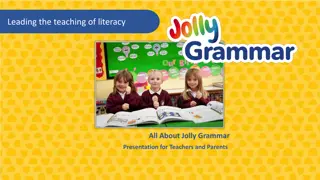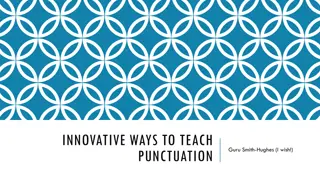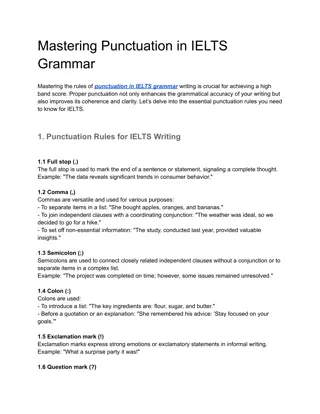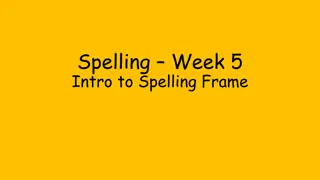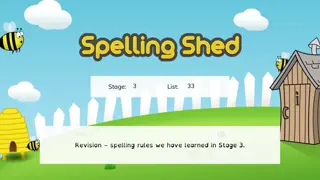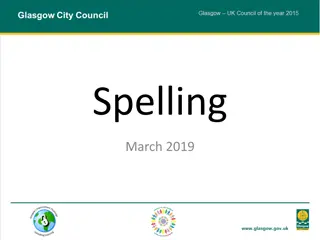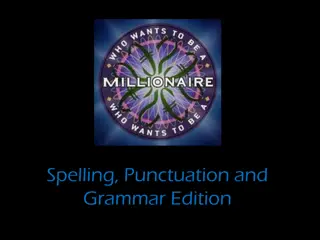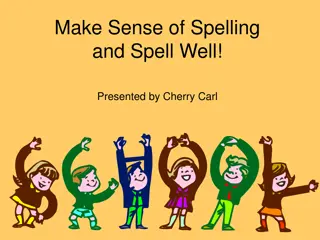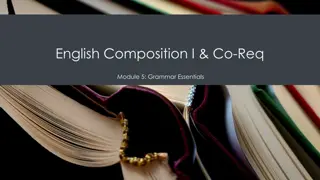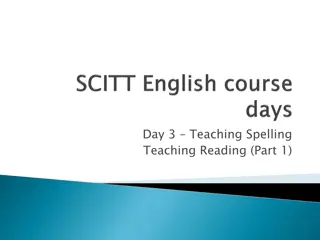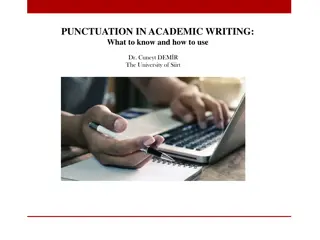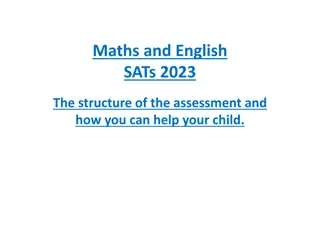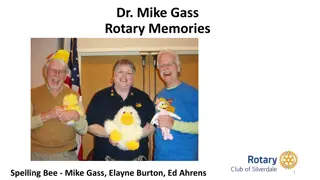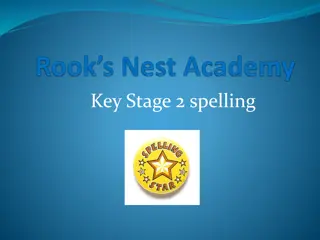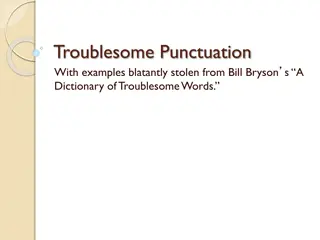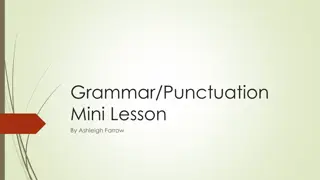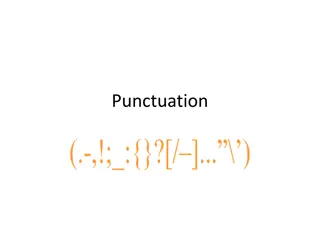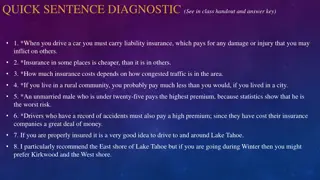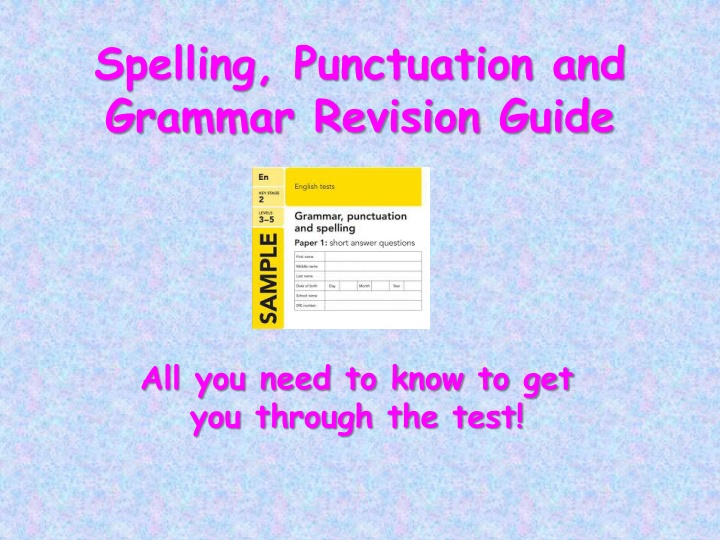
Grammar Guide: Nouns, Adjectives, and More
Dive into the world of grammar with this revision guide covering nouns, adjectives, and more. Learn about different types of nouns like proper and common, understand the role of adjectives in describing nouns, and explore interrogative and possessive adjectives. Enhance your knowledge of grammar with examples and explanations provided in this comprehensive guide.
Download Presentation

Please find below an Image/Link to download the presentation.
The content on the website is provided AS IS for your information and personal use only. It may not be sold, licensed, or shared on other websites without obtaining consent from the author. If you encounter any issues during the download, it is possible that the publisher has removed the file from their server.
You are allowed to download the files provided on this website for personal or commercial use, subject to the condition that they are used lawfully. All files are the property of their respective owners.
The content on the website is provided AS IS for your information and personal use only. It may not be sold, licensed, or shared on other websites without obtaining consent from the author.
E N D
Presentation Transcript
Spelling, Punctuation and Grammar Revision Guide All you need to know to get you through the test!
Noun A noun is a naming word: a word used for naming an animal, a person, a place or a thing. Queen Elizabeth II England dog chair
Proper nouns Proper nouns are used to name particular people and places: Jim, Betty, London - and some times : Monday, April, Easter. Proper nouns always begin with a capital letter.
Common nouns A common noun is a noun that is used to name everyday things: cars, toothbrushes, trees and kinds of people: man, woman, child.
Collective nouns Collective nouns describe a group or collection of people or things: army, bunch, team, swarm.
Abstract nouns An abstract noun describes things that cannot actually be seen, heard, smelt, felt or tasted: sleep, honesty, boredom, freedom, power.
Adjectives An adjective is a describing word: it is a word used to describe (or tell you more about) a noun. Example: The burglar was wearing a black jacket, a furry hat and a large mask over his face. An adjective usually comes before a noun but sometimes it can be separated from its noun and come afterwards (e.g.: Ben looked frightened; the dog was very fierce)
Interrogative (asking) Adjectives e.g.: What? Which? They are used to ask questions about a noun. Example: Which hat do you prefer?
Possessive Adjectives e.g.: my, our, their, his, your Possessive adjectives show ownership. Example.: Sue never brushes her hair.
Adjectives of number or quantity e.g. much, more, most, little, some, any, enough These answer the question: How much? Example: She invited five friends for dinner; she did not have any food left
Demonstrative (pointing-out) Adjectives e.g.: this, that, these, those Demonstrative adjectives answer the question: Which? Example: Those apples and these pears are delicious. That man stole this handbag.
Verbs A verb is a word, or a group of words, that tells you what a person or thing is being or doing. It is often called a doing word: e.g. running, eating, sitting. All sentences have a subject and a verb. The subject is the person or thing doing the action: Example: Cats purr (Cats is the subject and purr is the verb)
Auxiliary Verbs A verb is often made up of more than one word. The actual verb-word is helped out by parts of the special verbs: the verb to be and the verb to have. These helping verbs are called auxiliary verbs and can help us to form tenses. Auxiliary verbs for to be include: am, are, is, was, were, Auxiliary verbs for to have include: have, had, hasn t, has, will have, will not have. Examples: I have arrived ( arrived is the main verb and have is the auxiliary verb) We are waiting ( waiting is the main verb and are is the auxiliary verb)
Adverbs An adverb tells you more about the verb (it adds to the verb). It nearly always answers the questions: How? When? Where? or Why? Most adverbs in English end in ly and come from adjectives: E.g. soft softly; slow slowly.
Adverb or Adjective? Some words can be either adverbs or adjectives depending on what they do in a sentence, e.g. fast, hard, late. If they answer the questions: How? When? Where? or Why? they are adverbs. If they answer the question: What is it like? - they are adjectives, and will be telling you more about a specific noun. Examples: Life is hard. (adjective) Kim works hard. (adverb) The train arrived early. (adverb) I took an early train. (adjective)
Pronouns Sometimes you refer to a person or a thing not by its actual name, but by another word which stands for it. The word you use to stand for a noun is called a pronoun (which means for a noun ) We use pronouns so that we do not have to repeat the same nouns over again. Have a look at the following sentence: When Barnaby stroked the cat and listened to the cat purring softly, Barnaby felt calm and peaceful. Compare it with the same sentence where some of the nouns have been replaced by pronouns: When Barnaby stroked the cat and listened to it purring softly, he felt calm and peaceful.
Singular Pronouns Singular pronouns are used to refer to one person or thing. E.g.: I, you, me, he, she, it, you, him, her, mine, yours, his, hers, its
Plural Pronouns Plural pronouns are used to refer to more than one person or thing. E.g.: we, they, us, them, ours, yours, theirs
Prepositions Prepositions are words which show the relationship of one thing to another. Examples: Tom jumped over the cat. The monkey is in the tree. These words tell you where one thing is in relation to something else. Other examples of prepositions include: up, across, into, past, under, below, above
Connectives (conjunctions) Connectives (conjunctions) join together words, phrases, clauses and sentences. They help us to create compound sentences by joining two main clauses together. E.g.: She went to the shops. She bought a box of chocolates. We can use a conjunction to join these sentences together: She went to the shops and bought a box of chocolates. Other connectives (conjunctions) include: but, as, so, or
Subordinating connectives Subordinating connectives link a main (independent) clause with a subordinate (dependent) clause (a clause which does not make sense on its own). Example: When we got home, we were hungry. We were hungry because we hadn t eaten all day. Other subordinating connectives include: if, while, after, until, before , although
Articles An article is always used with and gives some information about a noun. There are three articles: a, an and the Examples: the chair; a table; an elephant *There is sometimes confusion about whether to use a or an. The sound of a word s first letter helps us to know which to use: If a word begins with a vowel sound, you should use an; if a word begins with a consonant sound, you should use a.
Statements These are sentences which state facts. e.g.: It is hot. The butter is in the fridge.
Questions Questions are sentences which ask for an answer. e.g.: Are you hot? Where is the butter?
Commands These are sentences which give orders or requests. e.g.: Play the movie. Give me a dinosaur for my birthday.
Exclamations Exclamatory sentences (exclamations) are sentences which express a strong feeling of emotion. e.g.: My goodness, it s hot! I absolutely love this movie!
Clauses A clause is a group of words which does contain a verb; it is part of a sentence. There are two kinds of clauses: 1. A main clause (makes sense on its own) e.g.: Sue bought a new dress. 2. A subordinate clause (does not make sense on its own; it depends on the main clause for its meaning) Example Sue bought a new dress when she went shopping. when she went shopping is the subordinate clause because it would not make sense without the main clause.
Phrases A phrase is a group of words which does not make complete sense on its own and does not contain a verb. It is not a complete sentence. Example up the mountain
Synonyms These are words that have a similar meaning to another word. We use synonyms to make our writing more interesting. Bad - awful, terrible, horrible Happy - content, joyful, pleased Look - watch, stare, glaze Walk - stroll, crawl, tread
Antonyms These are words with the opposite meaning to another word. The antonym of up is down The antonym of tall is short The antonym of add is subtract
Word groups/ families These are groups of words that have a common feature or pattern - they have some of the same combinations of letters in them and a similar sound. at, cat, hat, and fat are a family of words with the "at" sound and letter combination in common. bike, hike, like, spike and strike are a family of words with the "ike" sound and letter combination in common. blame, came, fame, flame and game are a family of words with the "ame" sound and letter combination in common.
Prefixes Prefixes are added to the beginning of an existing word in order to create a new word with a different meaning. Adding un to happy to make unhappy Adding dis to appear to make disappear Adding re to try to make retry
Suffixes Suffixes are added to the end of an existing word to create a new word with a different meaning. Adding ish to child to make childish Adding able to like to make likeable Adding ion to act to make action
Root words Root words are words that have a meaning of their own but can be added to either with a prefix (before the root) or a suffix (after the root) to change the meaning of the word. Root words can often be helpful in finding out what a word means or where it is derived from. help is a root word It can grow into: helps helpful helped helping helpless unhelpful
Singular A singular noun names one person, place or thing (a single item). One bike One mango One dress One fly One turkey One half
Plural More than one person, place or thing. Most nouns are made into plurals by adding s: Three bikes Some nouns ending in o are made into plurals by adding es: Two mangoes Most nouns ending in hissing, shushing or buzzing sounds are made into plurals by adding es: Ten dresses For words ending in a vowel and then y, just add s: Eight turkeys For words ending in a consonant and then y, change -y to -i and add es: Five flies Most nouns ending in -f or-fe change to -ves in the plural: Six halves
Capital letter Used to denote the beginning of a sentence or a proper noun (names of particular places, things and people). Joel has multi sports every Monday afternoon at Roscoe Primary School. In January, the children will be visiting Chester Zoo.
Full stop Placed at the end of a sentence that is not a question or exclamation. Terry Pratchett's latest book is not yet out in paperback. I asked her whether she could tell me the way to Brighton.
Question marks Indicates a question/disbelief. Who else will be there? Is this really little Thomas?
Exclamation marks Indicates an interjection/surprise/strong emotion. What a triumph! I ve just about had enough! Wonderful!
Inverted commas Punctuation marks used in pairs ( ) to indicate: quotes (evidence). direct speech words that are defined, that follow certain phrases or that have special meaning. For direct speech: Janet asked, "Why can't we go today?" For quotes: The man claimed that he was shocked to hear the news . For words that are defined, that follow certain phrases or that have special meaning: 'Buch' is German for book. The book was signed 'Terry Pratchett'. The 'free gift' actually cost us forty pounds.
Apostrophes Used to show that letters have been left out (contractions) or to show possession (i.e. belonging to ) Contractions: Is not = isn t Could not = couldn t Showing Possession: With nouns (plural and singular) not ending in an s add 's: the girl s jacket, the children's books With plural nouns ending in an s, add only the apostrophe: the guards' duties, the Jones' house With singular nouns ending in an s, you can add either 's or an apostrophe alone: the witness's lie or the witness' lie (be consistent)
Commas in a list Used between a list of three or more words to replace the word and for all but the last instance. Jenny s favourite subjects are maths, literacy and art. Joe, Evan and Mike were chosen to sing at the service. The giant had a large head, hairy ears and two big, beady eyes.
Commas to mark phrases or clauses To indicate contrast: The snake was brown, not green, and it was quite small. Where the phrase (embedded clause) could be in brackets: The recipe, which we hadn't tried before, is very easy to follow. Where the phrase adds relevant information: Mr Hardy, aged 68, ran his first marathon five years ago. To mark a subordinate clause: If at first you don't succeed, try again. Though the snake was small, I still feared for my life. Introductory or opening phrases: In general, sixty-eight is quite old to run a marathon. On the whole, snakes only attack when riled. Conjunctive verbs: Unfortunately, the bear was already in a bad mood and, furthermore, pink wasn't its colour.
Brackets (parentheses) Used for additional information or explanation. To clarify information: Jamie's bike was red (bright red) with a yellow stripe. For asides and comments: The bear was pink (I kid you not). To give extra details: His first book (The Colour Of Magic) was written in 1989.
Ellipses Used to indicate a pause in speech or at the very end of a sentence so that words trail off into silence (this helps to create suspense). A pause in speech: The sight was awesome truly amazing. At end of a sentence to create suspense: Mr Daily gritted his teeth, gripped the scalpel tightly in his right hand and slowly advanced
Dashes Used to show interruption (often in dialogue) or to show repetition. To show interruption: The girl is my Sister, interrupted Miles, She looks just like you. To show repetition: You-you monster! cried the frightened woman. St-st-stop! stammered the boy.
Colons a) b) Used before a list, summary or quote Used to complete a statement of fact Before a list: I could only find three of the ingredients: sugar, flour and coconut. Before a summary: To summarise: we found the camp, set up our tent and then the bears attacked. Before a line of speech: Tom asked: May I have another cupcake? Before a statement of fact: There are only three kinds of people: the good, the bad and the ugly.
Semi-colons Used in place of a connective (conjunction). Shows thoughts on either side of it are balanced and connected. It can also separate words or items within a list. To link two separate sentences that are closely related: The children came home today; they had been away for a week. In a list: Star Trek, created by Gene Roddenberry; Babylon 5, by JMS; Buffy, by Joss Whedon; and Farscape, from the Henson Company.

